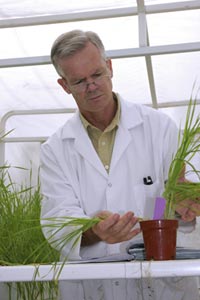
Researchers work to cut $100 million stripe rust fungicide bill

Dr Colin Wellings is urging farmers to try
new wheat varieties.
A NSW Department of Primary Industries (DPI) researcher has estimated that Australian farmers spent more than $100 million last season on fungicides to stamp out a severe stripe rust epidemic and achieve above average crop yields.
And unless farmers turn to new varieties boasting improved resistance to stripe rust, NSW DPI researcher, Dr Colin Wellings, believes farmers will pay dearly for relying solely on fungicides instead of resistance genes in new varieties.
“Despite the pleasing outcome of the 2005 harvest, it is expected that farmers will have incurred record expenditure on fungicides to contain the yield damaging effects of stripe rust,” Dr Wellings said.
“About $90 million was spent on stripe rust fungicides in 2004 and possibly more than $100 million in 2005 … these levels of expenditure are simply unsustainable for Australian dry land wheat growers.
“The future for wheat growers will reside in access to commercial wheat varieties with adequate stripe rust resistance.
“Australian wheat breeders, in co-operation with the Australian Cereal Rust Control Program, are making admirable progress developing new varieties with good stripe rust resistance.
“The introduction of a new strain of stripe rust in 2002 has meant that varieties that were moderately resistant became moderately susceptible and sometimes extremely susceptible.
“However, farmers can anticipate a significant improvement in stripe rust resistant varieties from 2006 including recently commercialised varieties Ventura and EGA Gregory.
“These and other varieties carry resistance genes Yr 17, Yr18 and Yr 33 which continue to provide good yield protection, especially when combined.”
Dr Wellings said that adoption of new varieties coupled with commitment to the removal of extremely susceptible varieties will bolster disease control in the future.
However, growers in northern NSW have the additional problem of weighing up which disease is considered the greater risk - crown rot or stripe rust.
Unfortunately, all current varieties which have useful levels of partial resistance to crown rot have only moderate resistance to stripe rust (4-5).
Variety choice therefore comes down to which disease is considered the greater risk, according to NSW DPI researcher Steven Simpfendorfer at Tamworth Agricultural Institute.
“In 2005 many growers learnt the hard way that crown rot resistance should be considered first,” he said.
“They lost significantly more to crown rot by switching to varieties with good stripe rust resistance but lower levels of partial resistance to crown rot.
“The additional losses to crown rot in these more susceptible varieties were generally considered far in excess of the potential cost of two in-crop foliar fungicide applications to control stripe rust.”
Dr Simpfendorfer said no in-crop management options are available for crown rot whilst stripe rust can be effectively controlled with fungicides.
“Current registered fungicides are all Group C in mode of action, and have given good control when applied correctly. Nevertheless, it is the cost of fungicides that is a major limiting factor to their long-term adoption.”
Growers are encouraged to consult the latest agronomic advice when selecting varieties for the 2006 season, taking care to consider the range of production issues in addition to stripe rust.
Further information
NSW DPI research into crown rot is funded by DPI and the Grains Research and Development Corporation.
Dr Col Wellings, NSW DPI, Menangle on 02 9351 8826 or Dr Steven Simpfendorfer, NSW DPI Tamworth on 02 6763 1261.
Email:

